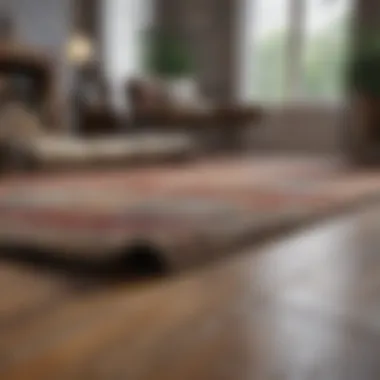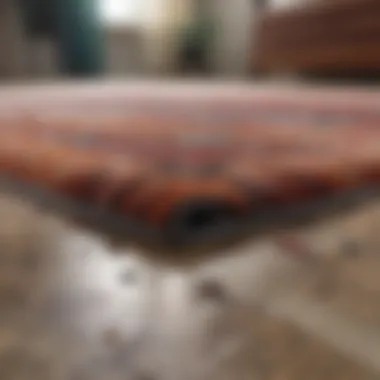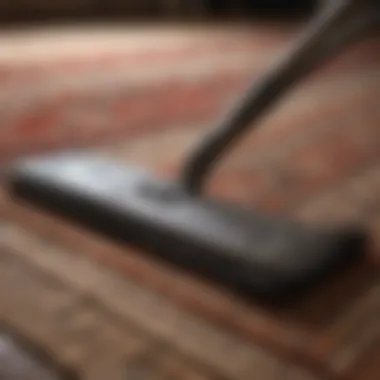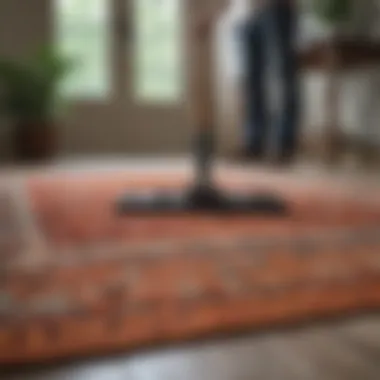Complete Guide to Area Rug Cleaning Techniques


Intro
Area rugs often serve as the emotional centerpiece of a room, drawing the eye and tying together various elements of a home's decor. With a patchwork of colors, patterns, and textures, they can elevate a space beyond mere functionality. However, keeping these rugs clean and vibrant requires more than the occasional shake or vacuum. It necessitates a comprehensive understanding of materials, stains, and maintenance techniques to preserve their beauty and prolong their lifespan.
Understanding the unique characteristics of your area rug is the first step in any effective care plan. Different materials such as wool, silk, cotton, or synthetic fibers each have specific needs. Moreover, regular upkeep helps maintain the fabric's integrity, while targeted cleaning can tackle stubborn stains that threaten to ruin your prized possession.
As we delve into the complexities of rug cleaning, this guide will illuminate vital methods and considerations. Whether you’re dealing with a coffee spill on a delicate silk rug or just looking to refresh an old wool piece, we've got you covered. Get ready to transform your cleaning routine into something as artful as the rugs themselves.
Understanding Area Rugs
Rugs have a distinct way of tying a room together, offering both aesthetic appeal and functional comfort. Understanding area rugs encompasses not just their types and materials, but also their role in enhancing a space. This section prepares you to delve deeper into cleaning and maintaining these valuable items, emphasizing why knowing the ins and outs of area rugs can make a world of difference in your home or workspace.
Types of Area Rugs
Natural fiber rugs
Natural fiber rugs are crafted from materials sourced from nature, such as jute, sisal, or seagrass. Their eco-friendly origins contribute to a rustic charm that many homeowners appreciate. A striking characteristic is their breathability, which allows them to resist moisture and mold. They are popular in beachy or rustic themes, and their durability is a big draw. However, they can be less soft underfoot and may require more care, particularly in damp conditions.
Synthetic fiber rugs
In the realm of durability, synthetic fiber rugs come out on top. Made from materials like polyester or nylon, they offer a myriad of styles and colors, catering to a plethora of design preferences. One of their key selling points is their resistance to stains and fading, making them a forgiving choice for busy families. Yet, while they are incredibly easy to clean, some might argue they lack the classic charm found in natural fibers.
Wool rugs
Regarded as the gold standard by many, wool rugs boast inherent resilience and insulation properties. These rugs are not just warm; they are also naturally stain-resistant and do a good job of keeping allergens at bay. They provide a luxurious touch to any space, which contributes to their popularity. The downside? Wool can be prone to shedding and is often on the pricier side.
Silk rugs
Silk rugs are often seen as a luxury. They create a breathtaking elegance in any room. Their natural sheen stands out, and the weaving often incorporates intricate patterns. However, they require delicate care and can be quite sensitive to water and stains, making them a less practical choice for high-traffic areas.
Cotton rugs
Cotton rugs are the little white lies of the rug world. They can serve as the perfect solution for light, casual spaces. Affordable and machine-washable, these rugs come in countless patterns and colors. However, they might not be as durable as their woolen or synthetic counterparts, making them less suitable for heavy wear. Their lightweight nature makes them easy to move and rearrange, a big plus for those who like to refresh their decor frequently.
Common Uses and Placement
Rugs in living areas
Living areas often see the greatest foot traffic, making rugs here a common sight. Their primary function is to define seating areas and add warmth to cold flooring. By choosing the right rugs, one can transform an ordinary room into an inviting sanctuary. Often placed under coffee tables or sofas, a well-positioned rug can visually enhance the space. But one must be cautious; too small a rug can look out of place, making the area seem disjointed.
Rugs in dining spaces
Placing rugs under dining tables can protect flooring from scratches and spills while adding an element of style. They can also encourage a cozy atmosphere conducive to conversation. A good rule of thumb is to ensure the rug extends a few feet beyond the table's perimeter; otherwise, chairs that slide can create a disheveled look. However, it's important to select a rug that's durable enough to withstand the occasional spill and frequent cleaning.
Rugs in bedrooms
In bedrooms, rugs soften the cold floors and create a comforting environment for waking up and winding down. Placing rugs beside or underneath beds can add warmth underfoot, transforming the cold morning routine into a more pleasant experience. Soft, plush rugs make a cozy statement, yet they require mindful selection based on allergy sensitivities, especially for those who may be prone to dust.
Rugs in commercial settings
In commercial environments, rugs serve both practical and aesthetic purposes. They welcome guests, define waiting areas, and can even cushion footfalls in busy healthcare settings. Durability and ease of maintenance are key factors to consider here. While aesthetics are essential, the high traffic means that moisture and dirt-wicking capabilities become top priorities in selection.
Assessing Your Rug's Condition
Before diving into the cleaning process, it’s critical to grasp the state of your area rugs. Assessing your rug's condition helps inform the cleaning approach, ensuring favorable outcomes without risking damage. Understanding what your rug is made of, identifying existing dirt and stains, and knowing when maintenance is due can make a world of difference.
Identifying Dirt and Stains
Types of dirt
When it comes to area rugs, dirt can play the role of an unwelcome guest. Sand, dust, and pet hair are the usual culprits that congregate on the fibers. Each type of dirt brings its own challenges; for instance, sand can act like tiny abrasives, rapidly wearing down fabric if not addressed. Dust, on the other hand, settles in and can dull vibrant colors over time.
One key aspect of this dirt is its sheer tenacity. Having a good, old-fashioned vacuum cleaner can work wonders. However, a more targeted approach might be necessary depending on the dirt type at hand. For a well-rounded cleaning strategy, getting familiar with these varieties is essential.
Common stains and their causes
Stains tell stories, and in the world of area rugs, they can narrate quite a tale. Coffee spills, pet accidents, and red wine mishaps are all commonplace dramas that unfold. The pervasive nature of these stains is a vital factor - they can set in quickly, especially if left untreated.
Understanding these common stains is crucial for effective cleaning. For example, coffee may not seem harmful, but it can quickly oxidize and become stubborn if ignored. Identifying the causes of these stains makes your approach to cleaning more efficient and helps in selecting the right products.
Discoloration and wear
As rugs age, discoloration and wear can take a toll on their charm. Fading due to sun exposure or the wear and tear from foot traffic can make an otherwise stunning piece look lackluster. This aging process has an impact not just on aesthetics but also on the rug's longevity.
Regular maintenance can help stave off such discoloration. Utilizing the right cleaning methods and materials suitable for the rug’s fibers protects against further deterioration. Keeping an eye on wear is also beneficial to know when it might be time to consult a professional.
Determining Cleaning Needs
Frequency of cleaning
Just like a garden that requires regular watering, your rugs also need consistent attention. The frequency of cleaning significantly influences the maintenance life of an area rug. Heavy foot traffic areas may need cleaning every few months, whereas rugs in more serene spaces can often go longer.
Being aware of these factors can set you up for success. For example, a rug used in a dining area might suffer more spills and, therefore, demand more frequent cleaning. Schedule regular check-ins to determine how often your rug needs a good clean based on its use between the seasons.
Types of stains


Understanding the specific types of stains on your rug provides key insight when establishing your cleaning needs. For instance, organic stains like food or drink often require different removal strategies compared to synthetic stains like ink or dye.
This recognition can determine if a simple spot clean will suffice or if it warrants more intense cleaning approaches. Keeping a mental log of these stains helps inform your routine maintenance. It’s a way of being proactive rather than reactive.
Rug material considerations
Finally, take a moment to think about what your rug is composed of. Wool, nylon, or cotton? Each material comes with its own set of cleaning considerations. For instance, wool rugs are generally more retainable to stains, while synthetic fibers can be more resilient against typical wear.
Familiarity with these material properties can help when deciding on cleaning tools and solutions. It is beneficial not to use harsh chemicals that could ruin the weave of fine silk but also be cautious of the moisture levels when cleaning natural fibers. Making these nuanced decisions can help prolong the life of your area rug, keeping it beautiful for years to come.
Tools and Materials for Cleaning
Understanding what tools and materials you need for cleaning area rugs is crucial to maintain their appearance and longevity. The right tools not only facilitate a more efficient cleaning process but also help protect the fabric and colors of your rugs. When it comes down to rug cleaning, investing in appropriate materials can save you a decent chunk of change down the line, preventing costly replacements or professional cleanings.
Essential Cleaning Tools
Vacuum cleaners
The vacuum cleaner stands as a pillar in the realm of rug cleaning. Its primary role is to remove dust, dirt, and allergens from the fibers without causing damage. Many folks opt for upright vacuum cleaners because of their strong suction and versatility. One standout feature is the adjustable height settings; they let you customize how close to the rug the machine can get, keeping delicate weaves intact.
While vacuums can be a game-changer, not all models are rug-friendly. Some may have roller brushes that can snag fibers, so choosing one designed specifically for area rugs can prevent a sticky situation. Regular vacuuming should be an integral part of your rug maintenance routine, as it keeps debris from settling in.
Soft bristle brushes
Soft bristle brushes are a fabulous tool when it comes to maintaining the texture and look of your rugs. They ensure deep cleaning while being gentle on the fabric. These brushes are particularly beneficial for rugs made from natural fibers, as it minimizes the risk of damage that stiffer bristles might cause. The key characteristic of soft bristle brushes is their ability to unclog fibers while lifting dirt that vacuuming might miss.
A unique feature of these brushes is their versatility; they can be used for both dry cleaning and spot cleaning. However, they require a bit of elbow grease and can be time-consuming for larger areas. Simply put, if you want to keep your area rugs looking plush and cozy, investing in a quality soft bristle brush is a good move.
Cleaning cloths
Cleaning cloths can sometimes get overlooked, but they play a pivotal role in rug care. Whether chosen for spot cleaning or general upkeep, having the right cloth can make a significant difference. Microfiber cloths are often the go-to option. They are known for their high absorbency, making them perfect for tackling spills without spreading moisture or grime.
One of the unique features is that microfiber cloths trap allergens and dirt rather than just moving them around, providing more effective cleaning. An advantage many people appreciate is how they can be washed and reused, reducing waste over time. On the flip side, be cautious with rough cloths or those with texture — they might scratch or pull fibers from the rug.
Cleaning Solutions
Homemade cleaning solutions
Homemade cleaning solutions provide an eco-friendly alternative that can effectively clean area rugs. Many people utilize a simple combination of vinegar and water for general cleaning. This particular mixture is gentle yet effective, making it suitable for many rug materials. Its key characteristic? It cuts through grime without harsh chemicals that could harm your rug's fibers.
The unique appeal of homemade solutions lies in their adaptability; you can tweak the ingredients based on your specific rug material and cleaning needs. However, it is crucial to do a patch test before applying it all over your rug. While they often do the trick, homemade solutions sometimes lack the heavy-duty strength required for more stubborn stains.
Commercial cleaners
On the other end of the spectrum, commercial cleaners bring convenience and specific formulations designed for different stain types. They issue a quick solution when things get messy. Their primary advantage is that many contain enzymatic properties which effectively tackle organic stains like food or pet messes. Their consistency and strength in stain-fighting make commercial cleaners a popular choice in many households.
However, caution is necessary as not all cleaners are created equal. Some might contain harsh chemicals which can fade colors or damage natural fibers. Thus, always check whether the product is safe for your specific rug material before diving in.
Specific stain removal products
When it comes to particularly tough stains, having a specific stain removal product on hand can be a lifesaver. These products are often targeted to address specific issues like pet stains, wine spills, or grease marks. Their key characteristic is that they are usually concentrated, meaning that a little goes a long way.
Uniquely formulated with active enzymes, these removers are great for breaking down stains at a molecular level. The advantage? You get a focused response to a nasty problem without going through a whole rigmarole of cleaning. One drawback is that they can be more costly and might require a bit of research to find the right one for your rug type.
Remember, knowing the right tools and materials to use in cleaning helps maintain both the effectiveness of your cleaning process and the integrity of your rugs.
Step-by-Step Cleaning Process
Cleaning area rugs is not just a chore; it’s a vital practice that extends the life of your rugs while preserving their beauty. When it comes to keeping these decorative pieces in top-notch condition, following a well-structured cleaning process is essential. This guide provides a comprehensive roadmap to ensure that your rugs maintain their appearance and durability for years to come. From preventing stains to deep cleaning, each step plays a significant role in the overall care of your area rug.
Routine Vacuuming
Regular vacuuming serves as the backbone of rug maintenance. Not only does it remove dirt and debris, but it also helps to prevent the fibers from becoming matted or damaged. The frequency of vacuuming can vary based on foot traffic.
How often to vacuum
For households with pets or high foot traffic, a good rule of thumb is to vacuum at least twice a week. This frequency keeps dirt at bay and reduces the workload during deep cleaning sessions. Vacuuming once a week is adequate for low-traffic areas, but the goal is always to catch the dirt before it settles in the fibers, which can cause permanent damage. The unique advantage of routine vacuuming is that it lessens the likelihood of ground-in stains that are much tougher to address later.
Techniques for effective vacuuming
Knowing how to vacuum effectively can make a world of difference. Use the vacuum cleaner on the right settings – higher settings can damage delicate fibers, while lower settings might not pick up all the dirt. Moreover, a back-and-forth motion allows for a thorough clean, ensuring you cover every inch. Utilizing a vacuum with a beater bar can help lift stubborn dirt, but always ensure it’s safe for your rug’s material. The benefit of mastering effective vacuuming techniques is twofold: your area rug will look better immediately, and it will be less susceptible to damage long-term.
Spot Cleaning Stains
In the life of an area rug, stains are inevitable. The response to them can dictate how your rug fares over time. Spot cleaning is critical because it allows you to address mishaps before they set into the fabric permanently.
Immediate response to spills
When life gets messy and spills happen, acting quickly is paramount. Blotting the area with a clean, dry cloth can help soak up excess liquid, preventing it from seeping deeper into the fibers. The idea is not to rub but to gently press down so that you’re lifting the stain instead of pushing it in. The immediacy of this response can greatly reduce the likelihood of permanent marks, making it a highly effective choice in this guide.
Techniques for various stains
Not every stain is created equal. From red wine to ink, the best approach involves identifying the nature of the stain before applying a remedy. For instance, a mix of mild detergent and water works wonders on food stains, but for something like ink, it might be better to use rubbing alcohol. The key characteristic of applying specific techniques for different stains ensures that you're not making matters worse. It’s always wise to test any solution on a hidden part of the rug before applying it to the stain.
Deep Cleaning Methods


Routine and spot cleaning can take the rug only so far. Deep cleaning methods are where the magic happens, helping to breathe new life into rugs that look tired and worn.
Steam cleaning
Steam cleaning is a popular method that involves using steam to lift dirt without the need for harsh chemicals. The heat also works to eliminate bacteria and allergens, leaving the rug looking fresh. This method is especially beneficial for rugs that have seen better days, as the steam penetrates the fibers deeply. One drawback, however, can be the drying time.
Shampoo cleaning
Shampoo cleaning employs specially formulated liquid solutions that act on the dirt, breaking down residue and odors. This process often leaves the rug feeling soft and revived. However, an important point to consider is the rinsing process; failing to thoroughly remove the shampoo can leave a sticky residue that attracts more dirt.
Dry cleaning methods
Dry cleaning offers a gentle way to clean rugs, especially those made from sensitive materials. Using minimal moisture reduces the risk of damage significantly. The unique advantage of dry cleaning is that rugs typically remain dry and can often be used soon after the process. The downside is that it may not reach deep-seated dirt as effectively as other methods.
In summary, each cleaning process provides a unique benefit to your area rugs, contributing to their longevity and appeal. By recognizing the importance of routine vacuuming, timely spot cleaning, and more thorough deep cleaning methods, you set the stage for stunning rugs that enhance your space for years to come.
Post-Cleaning Care
After you’ve put in the elbow grease to clean your area rugs, there’s still an important step that shouldn’t be overlooked: post-cleaning care. This phase is crucial for maintaining the pristine look and extending the lifespan of your rugs. By caring properly for your rug after cleaning, you ensure it not only stays looking sharp but also remains comfortable underfoot.
Drying Techniques
Air drying methods
Air drying is a widely recommended technique when it comes to post-cleaning care, especially for delicate fabrics. Unlike other methods that can potentially damage the fibers, air drying allows the rug to breathe. This technique works wonders without applying excessive heat, which can be detrimental to certain materials. The beauty of air drying is its simplicity—just lay the rug flat and let nature do its thing. It’s a safe option, allowing moisture to evaporate gradually.
The key characteristic here is that it minimizes the risk of damage or warping. However, it requires a bit of patience, depending on the climate. If you live in a humid area, it might take longer than you’d like. That’s something to keep in mind when planning your cleaning schedule.
"Proper air drying can make a world of difference in the longevity of your rug."
Using fans
If you’re looking to speed up the drying process without compromising the integrity of your rug, using fans can be an effective method. This technique essentially circulates air more rapidly, hastening evaporation. Fans are especially useful in humid conditions where air drying might otherwise take days.
The main advantage of using fans is that they can significantly reduce the drying time while maintaining a gentle breeze that won’t harm the rug's fibers. Just place the fan at a distance to ensure the airflow is soothing rather than forceful. One downside? If not managed properly, fans can create trivial dust, which means you might need to do a quick wipe-down of your rug after it's dry. Overall, though, fans can be quite beneficial for those who need their rugs to dry quickly!
Rearranging and Fluffing
Flattening creases
When rugs are cleaned and dried, they often develop creases. Flattening these creases is necessary for a uniform appearance and to avoid trip hazards. The process involves simply walking on the affected areas gently, or you can use a heavy object to help smooth out the fabric.
This step is significant because it also helps restore the rug's original shape, enhancing its aesthetic appeal. One must ensure to do it with care—it’s rather delicate work that could potentially lead to damage if done carelessly.
Rearranging fibers
Rearranging the fibers of the rug is essential to maintain its look and feel after cleaning. Over time, even the most well-cared-for rugs can lose some of their original bounce. This step can include gently brushing the rug with a soft bristle brush or your hands, ensuring that the fibers stand upright instead of lying flat.
This method has the dual benefit of improving appearance and texture. It enhances the cozy sensation underfoot, which is one reason many people adore rugs in their homes. Regularly rearranging fibers can also prevent matting, which is something every rug owner should strive for.
Common Mistakes to Avoid
When it comes to cleaning area rugs, a bit of caution can save you from bigger headaches down the line. Understanding common pitfall not only ensures the longevity of the rug but also maintains its aesthetic appeal. Committing these mistakes might very well lead to irreversible damage that can be costly to undo. In this section, we will delve deep into the blunders people frequently make and how to sidestep these traps.
Ignoring Material Guidelines
Not reading care labels
Not checking care labels is like wandering in a maze without a map; you're setting yourself up for confusion and risk. Care labels are there for a reason, offering insights about appropriate cleaning agents and methods specific to the rug’s fabric. Ignoring these labels can lead to mishaps such as shrinking, fading, or even causing material to seize up. Key characteristic? They serve as a guideline, letting you know which cleaning products are safe. It’s a smart choice for anyone looking to preserve their investment and it’s incredibly beneficial because it removes the guesswork.
However, overlooking such details means you're walking a tightrope without a safety net. One unique feature of care labels is their ability to point out any special treatments or finishes that the rug may have received, which can be forgotten when using a general cleaning method. This contributes significantly to the goal of maintaining area rugs in top-notch condition and avoiding costly mistakes.
Using inappropriate cleaners
Using the wrong cleaner is akin to using a sledgehammer to crack a nut. It might seem like it’ll do the job, but often it ends up causing more harm than good. Specific cleaners can react adversely with the materials of your rug, leading to damage, discoloration, or weakening of fibers. The key characteristic here is that the right cleaner can restore the rug’s beauty without risks. Choosing appropriate cleaners can not only improve effectiveness but also ensure that you don’t unwittingly reduce the life of your rug.
The downside of using wrong products can manifest in such ways as unpleasant odors or even attracting more dirt. Additionally, some commercial cleaners can leave behind residues that might dull the vibrancy of colors over time.
Overloading with Cleaning Products
Understanding dilution ratios
Understanding dilution ratios is all about balance. Overdo it with the product, and it might seem effective at first, but it often backfires. Too concentrated a solution can lead to buildup on the fibers, eventually attracting dirt instead of repelling it. This aspect contributes significantly to achieving a clean while maintaining the quality of your rug. Proper ratios not only maximize effectiveness but prevent damage that is often overlooked.
Furthermore, the uniqueness of this characteristic lies in its simplicity; with just a bit of knowledge about how much to use, you can make a big difference in care and maintenance of your area rugs. Too much product can not only damage the rug fibers but also create an unsightly film that makes the rug appear matted down.
Avoiding residue build-up
Avoiding residue build-up is crucial; no one wants to host a cleaning party only to find out that your efforts led to a gunky mess. Residue left behind from cleaning agents can become a magnet for dirt and grime, creating a cycle of frequent cleanings that becomes tiresome and achingly familiar. The key here is to follow manufacturers’ instructions not just on products, but how to best remove any excess.
One unique feature about keeping residue to a minimum is that it often leads to cleaner air quality – not just a cleaner rug! This benefit enhances the overall living environment and embodies a level of care that can be noticed by visitors.
Neglecting Regular Maintenance
Establishing a cleaning schedule


Establishing a cleaning schedule can feel like a chore, but neglecting it is where regrets kick in. A cleaning regimen allows you to maintain the rug in its peak condition, helping to prolong its life and visual appeal. This aspect is vital, as a consistent approach prevents the accumulation of dirt and stains that could lead to hefty costs down the road. Why is this a beneficial choice? It's like regularly servicing a car; when done right, it avoids catastrophic failures.
One unique feature of having a cleaning schedule is that it can often be tailored around your lifestyle, whether you’re entertaining frequently or have a houseful of pets. A personalized schedule ensures that your rug receives the necessary attention without feeling overwhelming.
Recognizing when to consult professionals
Recognizing when to consult professionals is key – just because you can DIY doesn’t mean you should. Sometimes, the extent of damage can exceed your comfort level and knowledge, leading to bigger headaches. The characteristic of this aspect lies in its prioritizing long-term benefit over short-term effort. Choosing to go the professional route may seem like a financial setback initially but can save you from costly damages in the future.
Additionally, one unique feature here is the complex knowledge professionals have about specific materials. Their expertise often translates to a higher quality of care that is hard to replicate at home, ensuring not just cleaning, but also preservation. The advantage of knowing when to bring in experts cannot be overstated, particularly in situations where deep cleaning or repairs are necessary.
Final Note: Mastering these common mistakes can enhance the longevity and appearance of your area rugs, creating a welcoming home environment.
Professional Cleaning Services
Cleaning area rugs can sometimes be a Herculean task. While many homeowners manage routine vacuuming and spot cleaning effectively, there will be times when seeking professional help becomes indispensable. Professional cleaning services offer expertise, precision, and tools that are often out of reach for the average homeowner. With delicate fibers and potential for significant damage with improper care, recognizing when to call in the experts is vital.
When to Seek Help
Extent of Damage
Knowing the extent of damage is crucial in determining whether professional cleaning is necessary. If a rug has seen better days—think of deep-set stains, water damage, or a general dinginess that won't budge—it's likely time to call in the pros. This aspect of rug care underscores the importance of specialized skills and advanced techniques used by professionals.
The key characteristic here is perceived value. A professional cleaner understands the anatomy of various rugs, meaning they can assess conditions that may be invisible to the untrained eye. This is why it becomes a sought-after choice in maintaining the quality of cherished rugs. The unique feature of expert services lies in their thorough approach; they use specialized products and methods aimed at restoring a rug to its prime condition. This results in stunning appearances and a long-lasting life for your rugs.
Types of Rugs Requiring Expert Care
Certain types of rugs are delicate and can suffer greatly from improper cleaning methods. For example, an antique silk rug or a Persian wool piece may not respond well to aggressive cleaning techniques. These rugs need specific knowledge and delicacy, often making professional care a beneficial choice.
The primary thing to keep in mind here is rug material. Different materials require varied cleaning approaches; failing to recognize this can lead to significant damage. Unique features include the use of non-toxic cleaning agents and soft cleaning processes specifically tailored to the fibers. Not only do these methods protect the rug's integrity, but they also help maintain the original character and hues, thus avoiding the disastrous consequences of DIY missteps.
Choosing a Professional Cleaner
Choosing the right cleaner is just as important as recognizing the need for professional assistance. The market is full of options, but the right choice can save you time, money, and heartbreak over a botched cleaning job.
Evaluating Credentials
When selecting a professional cleaner, evaluating credentials is paramount. This encompasses checking certifications, client reviews, and industry affiliations. A cleaner with the right credentials has often undergone rigorous training and adheres to standards that ensure quality results.
The characteristic here is trustworthiness. Knowing that a professional is certified instills confidence in the service being provided. Their unique feature could involve specialized training in advanced cleaning techniques, ensuring both effective and safe treatment of your rug. However, keep an eye out for overly flashy promises; credentials matter more than marketing hype.
Understanding Cleaning Processes
Finally, understanding cleaning processes used by professionals gives insight into what exactly happens to your rug. This aspect highlights transparency in service, allowing you to know whether the methods align with your expectations.
The significant characteristic is clarity and safety. Knowing what processes like steam cleaning or dry cleaning entail will help you make an informed decision. Being aware of the pros and cons of various treatments ensures you can anticipate how your rug will respond to them. A unique feature to look for is customization; a professional who tailors their approach to your rug type and condition is likely to offer the best results.
To maintain the beauty and longevity of your area rug, always know when it’s time to hand over the reins to expert cleaners—sometimes it's better to let a professional handle it!
Maintaining the Beauty of Your Area Rug
Area rugs add warmth and character to a space, acting as focal points in rooms where they reside. Maintaining their beauty isn't just about aesthetics; it involves preserving their integrity and longevity. If well-cared-for, rugs can last for generations, adding value and charm to your home. Neglecting them can lead to irreversible damage and costly replacements. Thus, incorporating a reliable routine for upkeep is paramount.
Preventive Measures
Using rug pads
Using rug pads beneath your area rugs is one of the simplest yet most effective preventive measures you can take. These pads serve multiple functions, such as preventing slipping and enhancing comfort underfoot.
One key characteristic of rug pads is their cushioning ability. They absorb some of the impacts from foot traffic, providing a barrier between the rug and the hard floor below. This not only protects the rug from wear over time but also minimizes the risk of accidents, making them a beneficial choice for any home.
Unique features of rug pads include their availability in various materials such as felt, rubber, and memory foam. Each type brings its own set of advantages—for instance, felt pads can add softness, while rubber ones offer excellent grip. However, one must consider the potential drawbacks, such as the possibility of rubber pads leaving residue on hardwood floors, which can be a hassle to clean.
Limiting exposure to sunlight
Limiting exposure to sunlight is another crucial aspect of maintaining your area rugs. Prolonged sun exposure can cause fading and discoloration, leading to a rug that looks worn and tired far before its time.
The primary characteristic of this preventive measure is its role in color preservation. Avoiding direct sunlight helps keep the rich hues of your rug intact, making it a popular choice among rug owners.
One unique aspect of limiting sunlight is its compatibility with various interior design styles. By using sheer curtains or placing rugs in shaded areas, homeowners can maintain their aesthetic choices while safeguarding their investments. The downside? If sunlight is not entirely avoided, some rugs may still experience gradual fading, which is why regular rotation of the rug can be helpful.
Regular Care Tips
Frequent fluffing
Frequent fluffing is often overlooked but serves a vital role in maintaining the plush appearance of your area rug. This process consists of lifting and shaking fibers gently to restore their lift and prevent matting.
A key characteristic of fluffing is its simplicity and effectiveness. Just a quick run-through with your hands or a soft brush can revitalize worn-looking fibers, making it a beneficial technique to incorporate into your routine.
The unique feature of frequent fluffing is that it aids in keeping dirt and debris from settling deep within the fibers. However, it’s important to avoid aggressive techniques that could damage delicate materials. A gentle touch goes a long way in preserving both appearance and structure.
Protecting from heavy furniture
Protecting your rug from heavy furniture is a crucial aspect of maintaining its beauty and integrity. Heavy items can create indentations over time, potentially leading to permanent damage.
A key characteristic of this practice is its preventive nature. By rearranging furniture periodically or using coasters designed for heavy items, you can help preserve the rug's original texture and shape. This makes it a beneficial strategy, especially in high-traffic areas.
The unique feature of protecting against heavy furniture is that it encourages a dynamic living space. Regularly changing the arrangement not only safeguards your rug but also brings freshness to your room. The tradeoff can be an initial effort in planning; however, the long-term benefits are well worth it.
"Preserving the beauty of your area rug is a balance of preventive care and regular attention."
In summary, taking the time to engage in these practices will prolong the life of your area rug and keep it looking vibrant and inviting.







